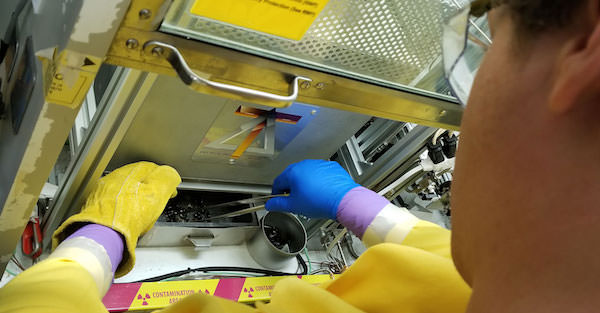
[Image above] Scientists melt radioactive waste into glass in a test platform at PNNL designed to mimic Direct Feed Low-Activity Waste system being constructed at Hanford. Credit: Pacific Northwest National Laboratory
According to the World Nuclear Association, the U.S. is the world’s largest producer of nuclear power. There are 99 nuclear reactors that produce nearly 20% of the total electrical output in the country.
And despite what the naysayers claim, nuclear energy is the largest source of clean energy in the U.S.
One of the biggest arguments in the debate about nuclear power is the issue of safe storage and disposal of nuclear waste.
One nuclear facility that has been undergoing major cleanup efforts is the Hanford Nuclear Site. The Department of Energy claims this has been one of the more challenging sites to clean up, as it contains nearly 56 million gallons of radioactive waste, most of which reside in 177 underground tanks. Hanford’s history goes back to World War II—when it was responsible for making plutonium for nuclear weapons. And cleanup of the facility has been going on for nearly 30 years after plutonium production halted in the 1980s.
Researchers at the Department of Energy’s Pacific Northwest National Laboratory have been working on vitrification processing for disposing of the low-level radioactive waste in those underground tanks.
Vitrification is a process that converts liquid and chemical waste into solid glass form. PNNL researchers demonstrated vitrification of three gallons of tank waste, which was an important first step toward treating all of that plutonium waste.
Recently, PNNL glass scientists conducted the first test of vitrification of actual waste.
“This was the first time low-activity Hanford tank waste has been vitrified in a continuous process, very similar to the treatment process that will be used at Hanford, rather than as a single batch,” glass scientist with DOE’s Office of River Protection Albert Kruger says in a PNNL news release. “The experience from this test will help us as we prepare for full-scale operations.”
The researchers took the liquid waste and mixed it with glass-forming materials while pumping it into a melter at 2100oF. They produced 20 pounds of glass in 20 hours.
“This successful test confirms the science and engineering approach,” Will Eaton, PNNL lead for the vitrification demonstration, says in the release. “Seeing actual Hanford low-activity waste being converted to glass is really exciting. It ties together 20 years of work from the design and construction of the Waste Treatment Plant to the research and testing that has supported that effort.”
The researchers plan to conduct another vitrification test later this year, using waste from another tank on the premises. Their test is part of a larger effort at Hanford to send low-activity waste from tank farms directly to a vitrification facility through a system currently under construction, called Direct Feed Low-Activity Waste (DFLAW).
To learn more about the DFLAW and the vitrification process at Hanford, watch the video below.
Want to read more articles like this? Subscribe to the Ceramic Tech Today newsletter to continue to receive the latest news in the ceramic and glass industry right in your inbox! Visit this linkto get started.
